Samsung 990 EVO Plus Gen 5 SSD Review
Samsung has long been a leader in the SSD industry, known for their ability to balance performance, reliability, and innovation across their product lines. From early offerings like the Samsung 960 EVO to their more recent hits like the 980 Pro, Samsung consistently delivers SSDs that push the envelope in both consumer and professional storage spaces. Their latest entry, the Samsung 990 EVO Plus, marks their first foray into the Gen 5 SSD market, but with a focus that differentiates it from some of the high-performance competition. While many other brands are racing to deliver the highest read/write speeds and performance benchmarks, Samsung has taken a more balanced approach here, focusing on efficiency, power consumption, and durability.
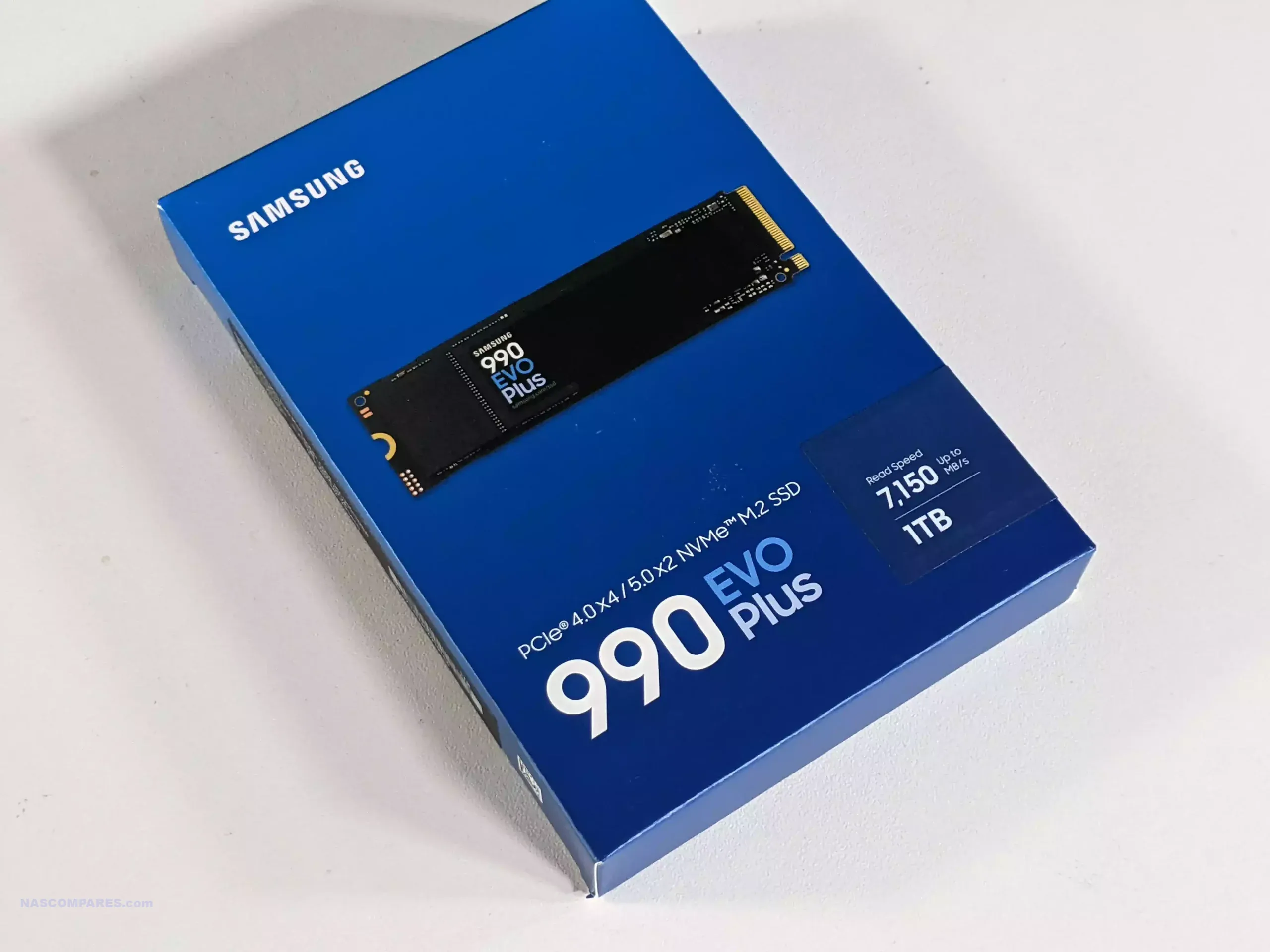
Building on the legacy of the Samsung 990 EVO, the 990 EVO Plus brings a number of upgrades in key areas, such as improved random performance, lower power consumption, and better thermal management. But is it enough to make a mark in the increasingly crowded Gen 5 SSD landscape? Let’s take an in-depth look at the Samsung 990 EVO Plus and see how it stacks up against both its predecessors and the competition.
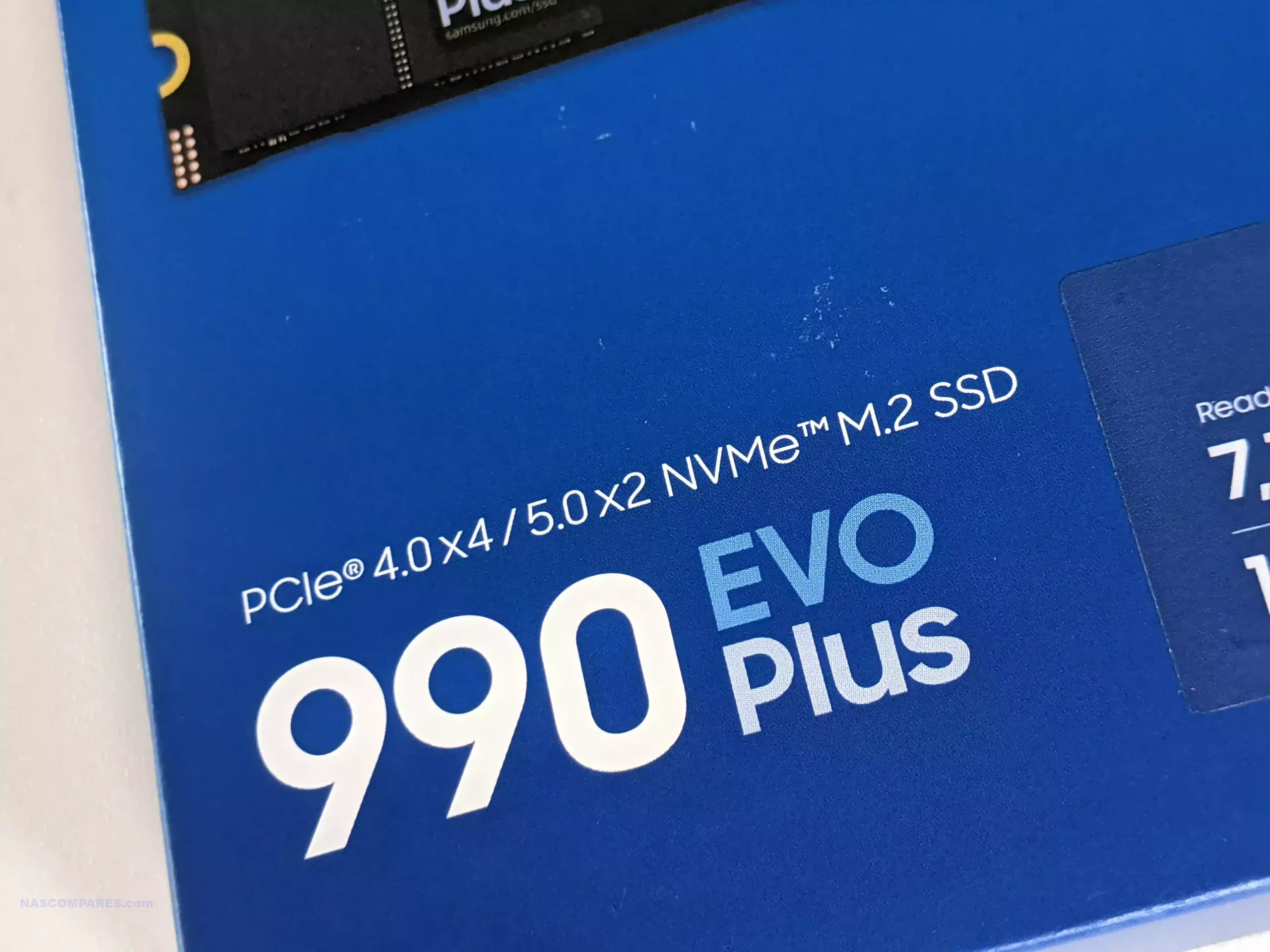
Samsung 990 EVO Plus Gen 5 SSD Review – Quick Conclusion
The Samsung 990 EVO Plus is a well-rounded SSD that balances power efficiency, random performance, and thermal management—making it an excellent choice for users who prioritize reliability and efficiency over raw speed. Compared to the 990 EVO, it offers significant improvements in power consumption and random performance, while still maintaining the same level of durability and endurance that Samsung is known for. However, for users who demand the absolute best in terms of sequential speeds or IOPS for gaming and data-heavy workloads, the 990 EVO Plus may not be the fastest option available. The lack of DRAM and the reliance on HMB technology might not appeal to those looking for top-tier performance, but for everyday users and professionals working with large files, this drive provides a reliable, long-lasting solution. The Samsung 990 EVO Plus shines as an efficient, reliable SSD for users who need dependable storage without the high power draw or heat output of some other Gen 5 SSDs. It may not be the fastest drive on the market, but its balance of power efficiency, random performance, and thermal management makes it a compelling option for a wide range of users. HOWEVER, but aware that this is a drive that is built for efficiency and if used in a mid-range system, will not hit the same performance numbers that a DRAM equipped SSD would be able to achieve. It’s another example of Samsung persuing a different SSD marketing and production strategy than Seagate and WD, but it’s still too early to see if this will be ultimately successful i nthe battle of Speed vs Efficiency vs Price in 2024/2025!
Where to Buy a Product





![]()
![]()

VISIT RETAILER ➤






![]()
![]()

VISIT RETAILER ➤
 DEAL WATCH – Is It On Offer Right Now? DEAL WATCH – Is It On Offer Right Now?These Offers are Checked Daily
|
Samsung 990 EVO Plus Gen 5 SSD Review – Retail Packaging
Samsung’s packaging for the 990 EVO Plus sticks to their traditional minimalist approach, providing the essentials without unnecessary extras. Inside the box, you’ll find the M.2 NVMe SSD in a protective plastic shell, along with basic installation instructions and information about the 5-year warranty. There’s no heatsink included, which is consistent with Samsung’s aim to keep the drive power-efficient and cool, but it’s worth noting that competitors in the Gen 5 space often include heatsinks to combat thermal throttling.

What stands out, though, is the Intelligent TurboWrite 2.0 technology integrated into the drive. This technology boosts write performance during large transfers by creating a pseudo-SLC cache, making it ideal for handling the larger file sizes that come with 8K video editing or high-resolution gaming.

The drive also comes equipped with a pre-applied base panel heat shield located beneath the NAND flash. Unlike other SSDs that place heat shields on the top, this design choice is part of Samsung’s commitment to improving thermal management without the need for active cooling solutions.
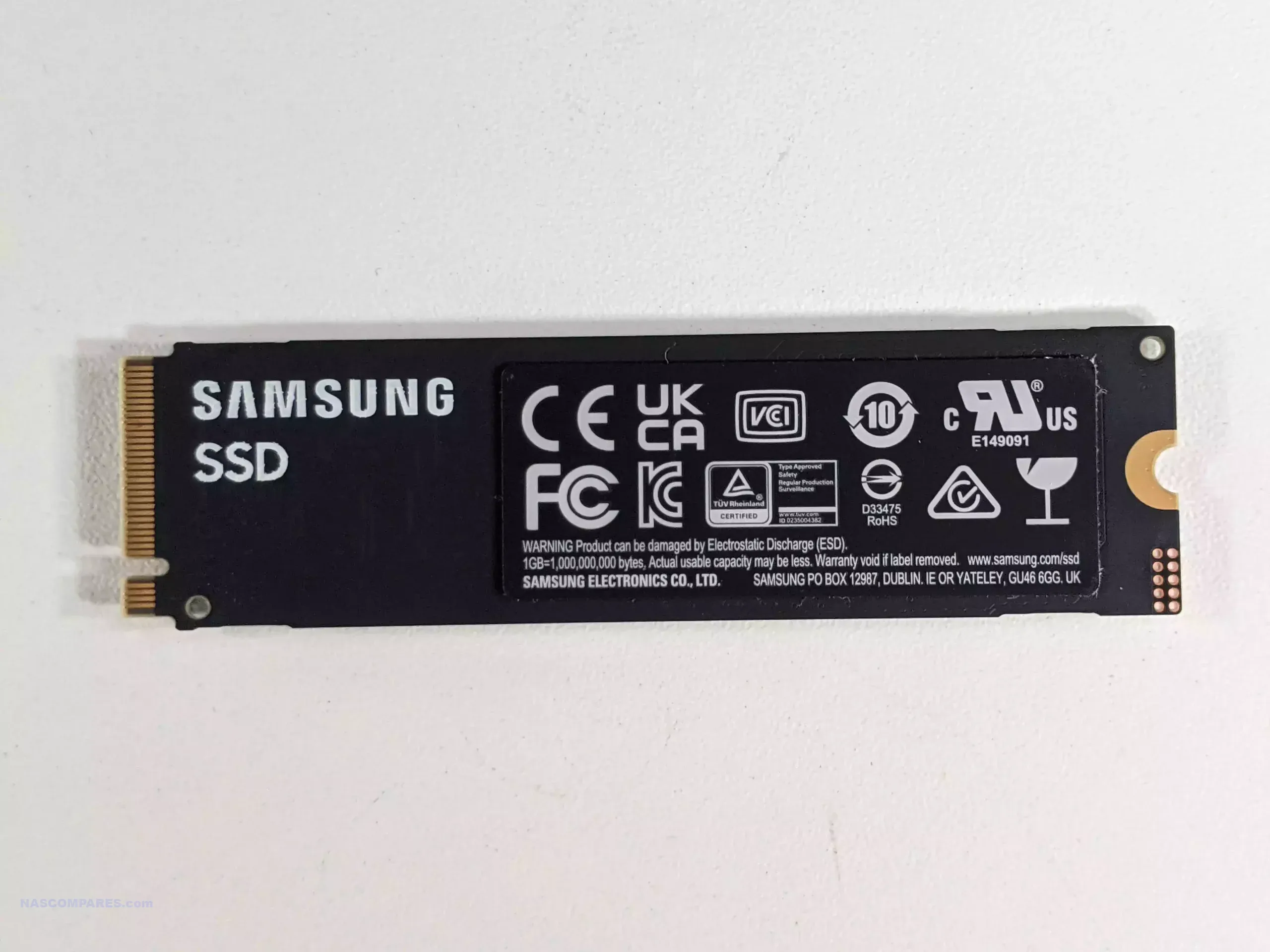
Samsung 990 EVO Plus Gen 5 SSD Review – Controller
The controller is one of the most critical components of any SSD, and for the Samsung 990 EVO Plus, Samsung continues to rely on its in-house expertise. The 990 EVO Plus features a Samsung proprietary controller designed specifically for this drive. This gives Samsung greater control over performance, efficiency, and longevity, allowing them to fine-tune the balance between speed and power consumption.
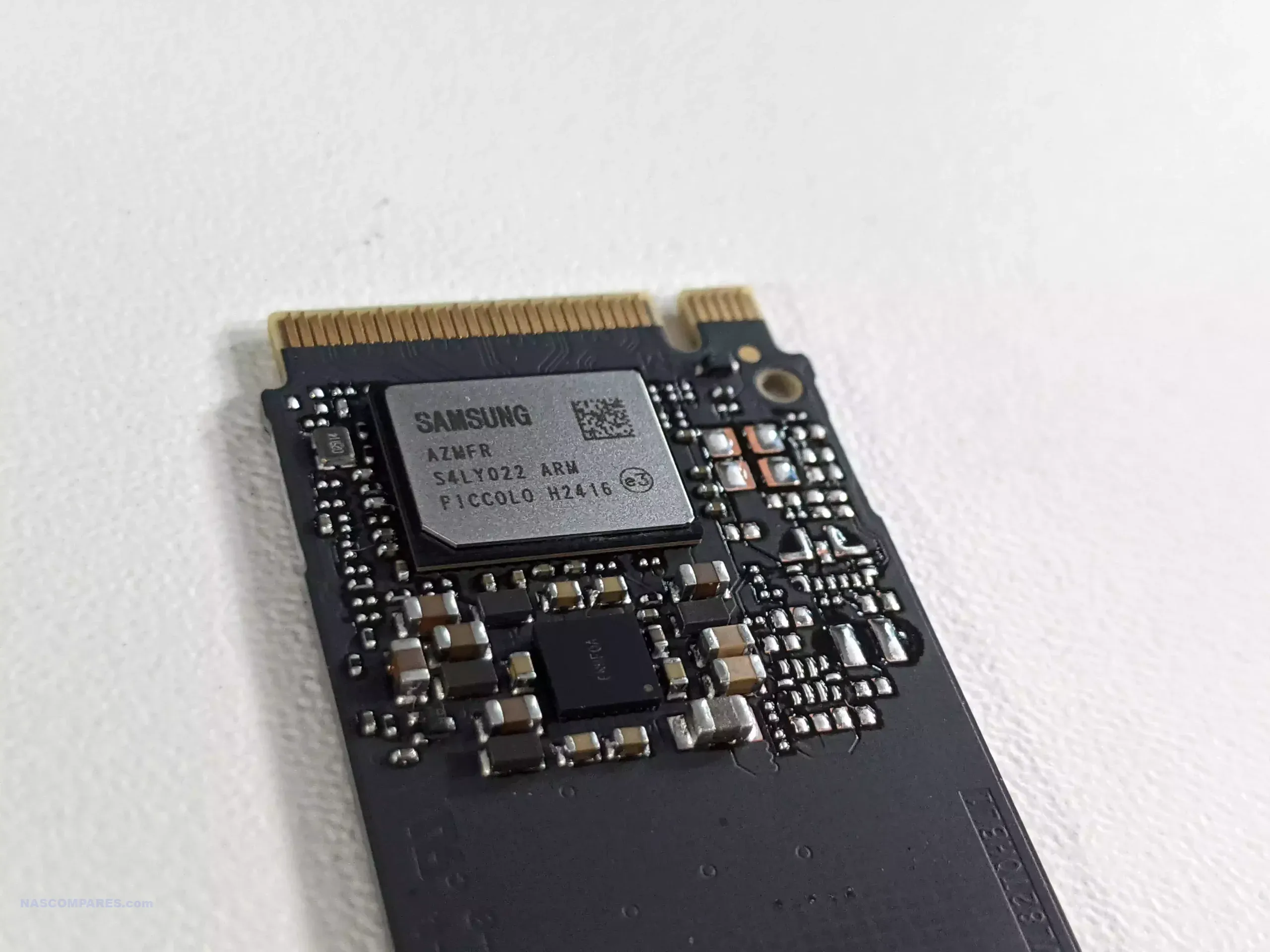
While Samsung hasn’t revealed the exact details of the controller in the 990 EVO plus publically, it is confirmed to be the Piccolo controller featured on the 990 EVO that was released earlier in 2024 and designed with power efficiency in mind. It supports PCIe Gen 5.0 x2, which, although not as fast as PCIe Gen 5.0 x4 drives, provides a significant boost over Gen 4 drives without the same high power draw or thermal challenges. By reducing the number of lanes while maintaining comparable performance, Samsung achieves lower temperatures and better power consumption than many competing drives, making the 990 EVO Plus ideal for compact or thermally constrained environments.
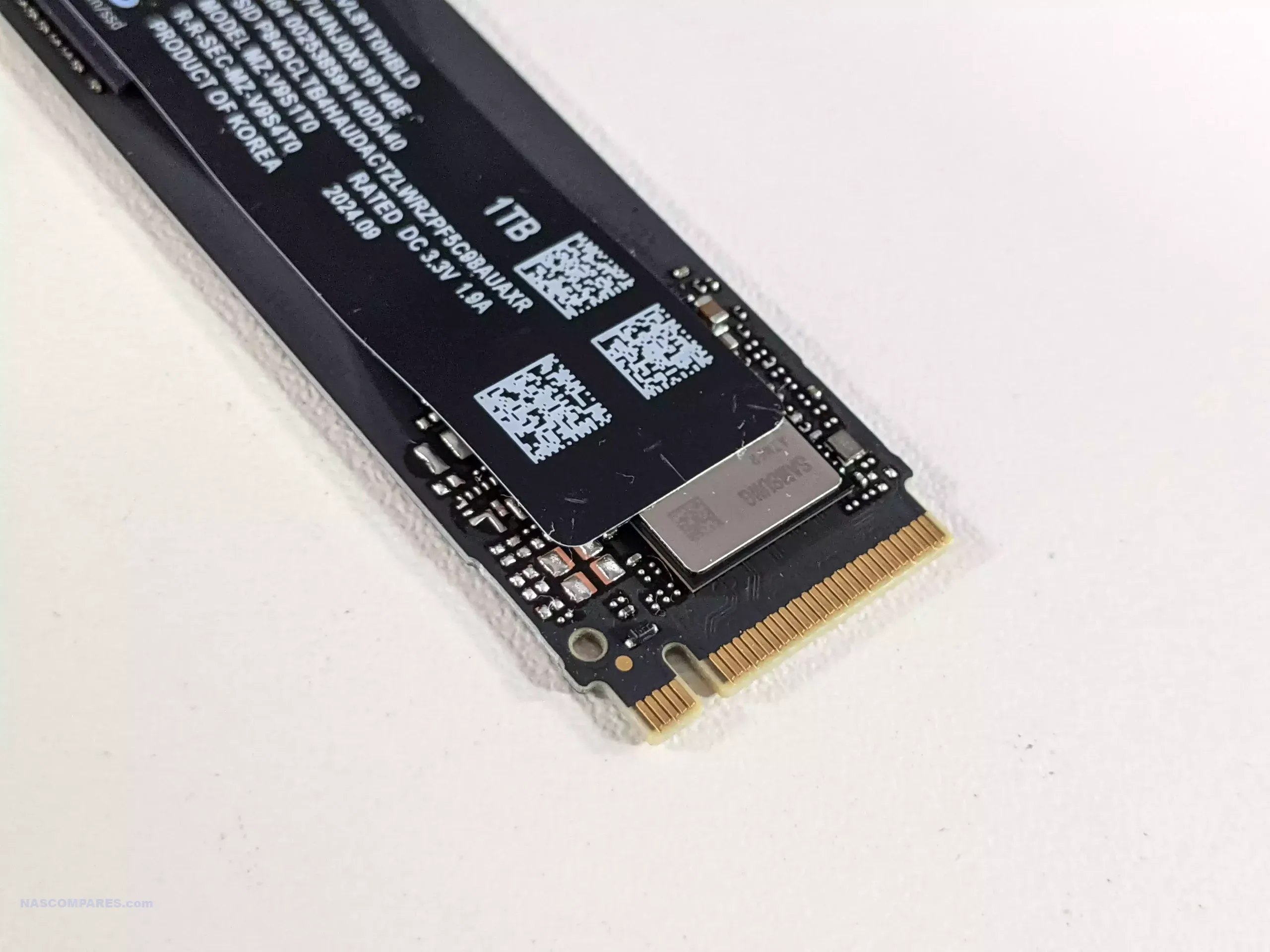
This is a different strategy compared to the Phison E31T controller, which prioritizes raw speed and high IOPS performance. Samsung’s approach in the 990 EVO Plus leans more towards stability and efficiency, making it suitable for a broader range of consumer devices like laptops and desktops that don’t require extreme sequential read/write speeds but need to maintain low power consumption and manage heat effectively. The 990 EVO Plus, with Samsung’s eighth V-NAND technology and Piccolo controller, delivers sequential read
and write speeds up to 7,250MB/s and 6,300MB/s, which improves the sequential read speed by 45% compared to the 990 EVO. And random read and write speeds are up to 1,050K and 1,400K IOPS. The best in-class performance of the 990 EVO Plus is the best solution for users who want to upgrade storage for versatile purposes
Samsung 990 EVO Plus Gen 5 SSD Review – NAND
The Samsung 990 EVO Plus uses the company’s 236-layer V-NAND TLC (Triple-Level Cell), a high-density, high-performance memory that strikes a balance between speed and durability. Samsung has long been a pioneer in NAND technology, and with the 990 EVO Plus, they have integrated their V-NAND V8 technology, which offers higher storage density and faster data transfer rates compared to previous generations.

The 236-layer V-NAND used in the 990 EVO Plus allows for more data to be stored in the same physical space, improving efficiency while keeping costs reasonable. The NAND chips are manufactured in-house, which ensures consistent quality and performance across the product line. In addition, Samsung’s Intelligent TurboWrite 2.0 technology works alongside the NAND to dynamically adjust the SLC cache, ensuring that large data transfers remain fast and efficient, even in sustained workloads like 8K video editing or rendering.
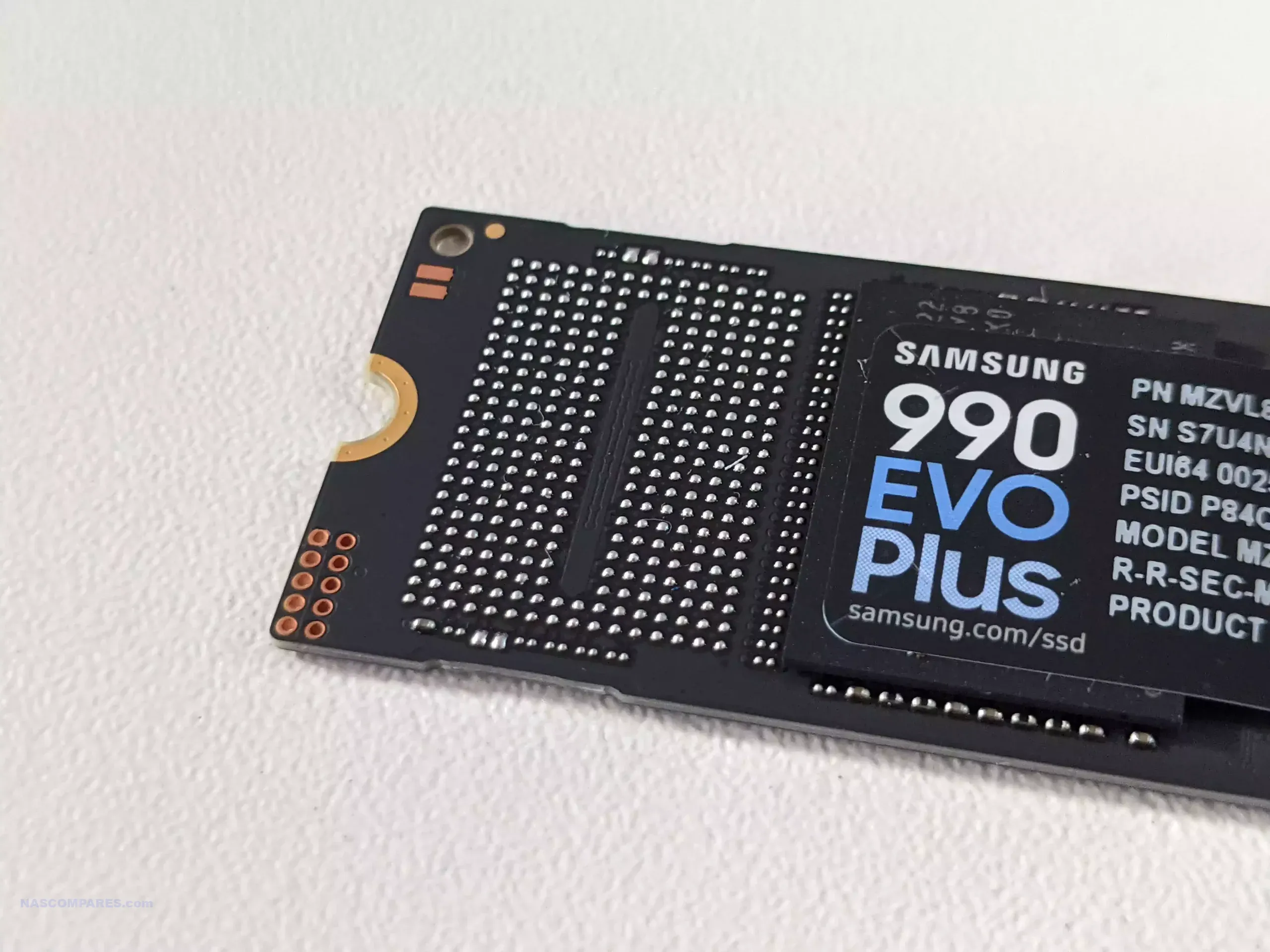
The high-density NAND also plays a key role in reducing power consumption, as the advanced node technology used in these chips allows for more efficient data processing with less energy, contributing to the drive’s overall power efficiency and thermal performance.
Samsung 990 EVO Plus Gen 5 SSD Review – Lack of DRAM and Host Memory Buffer (HMB)
One of the more significant design choices in the 990 EVO Plus is the absence of a dedicated DRAM cache. Instead, Samsung opts for Host Memory Buffer (HMB) technology, which uses a portion of the system’s main memory (RAM) to handle the mapping table needed for SSD operations.
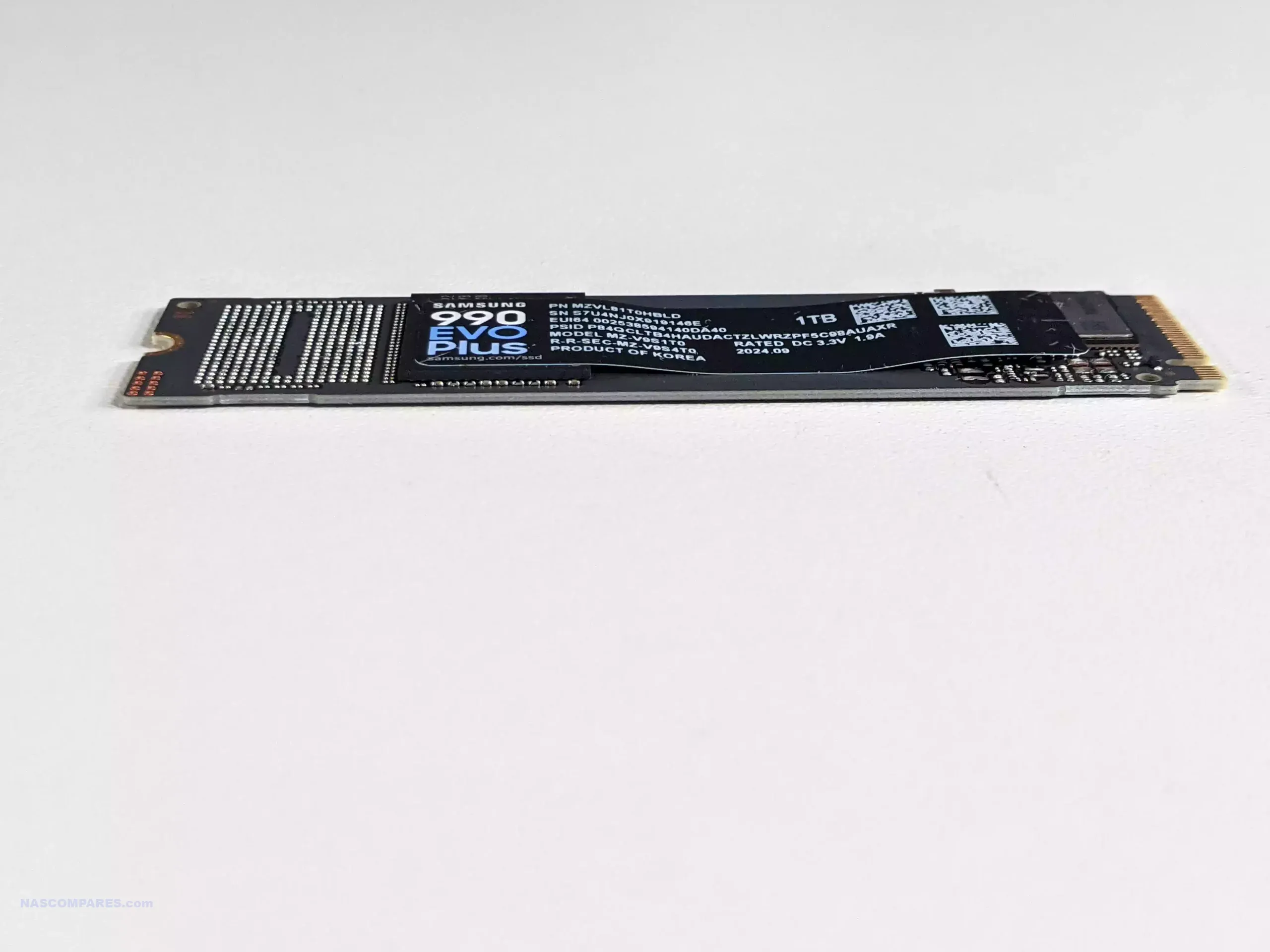
While DRAM-equipped SSDs generally offer faster performance due to the dedicated buffer for data mapping, the HMB implementation in the 990 EVO Plus is designed to mitigate some of the performance loss typically associated with DRAMless SSDs. By borrowing from the system’s RAM, the drive can still manage high IOPS and maintain relatively quick random access speeds, even in workloads that involve frequent small file transactions like gaming or document editing.
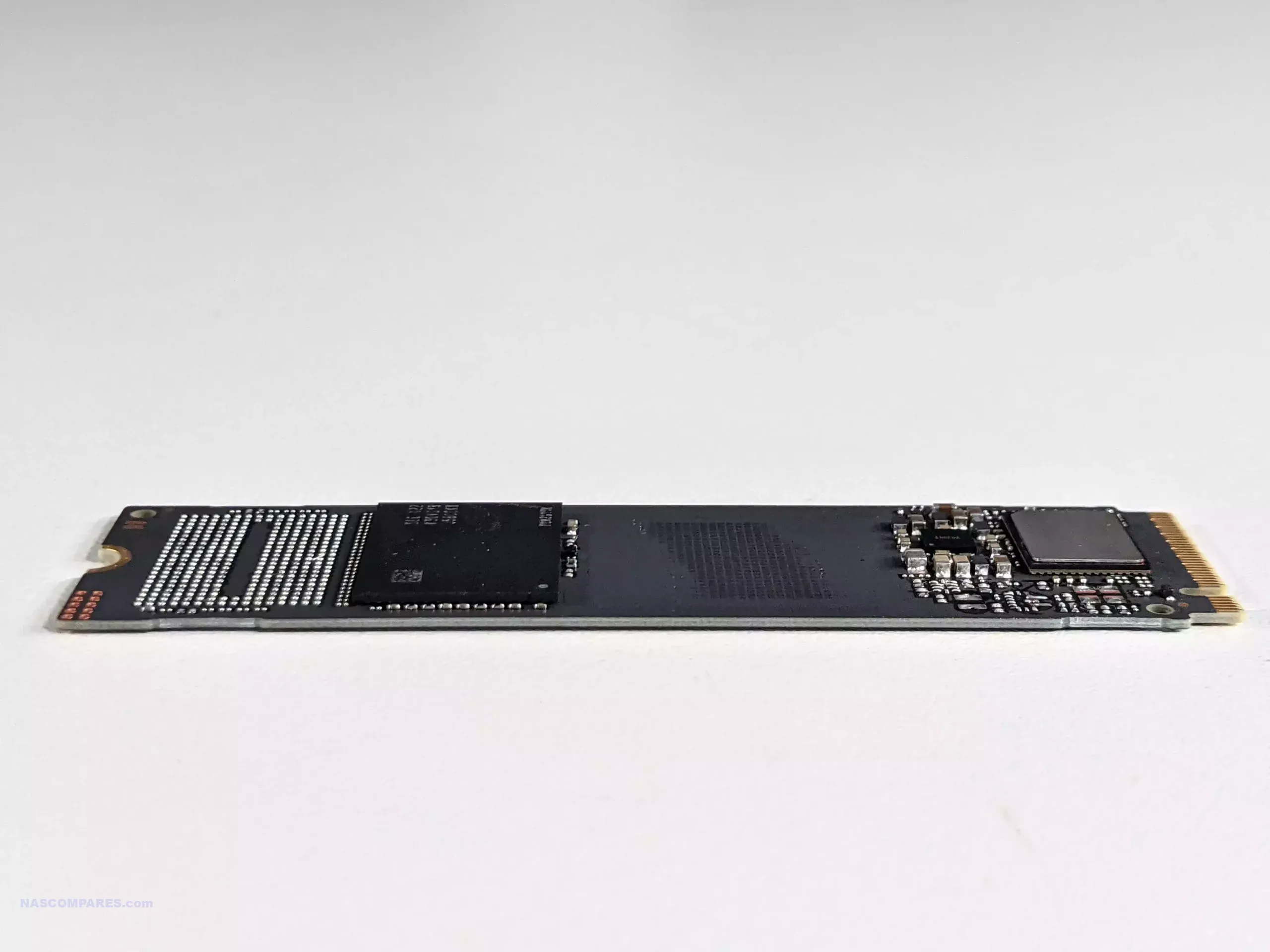
The key advantage of this DRAMless design is cost efficiency and reduced power consumption. SSDs with DRAM tend to consume more power, which isn’t ideal for compact systems or laptops where battery life and heat generation are critical factors. The 990 EVO Plus strikes a balance by using HMB to offer solid performance at a lower cost and with lower power requirements, making it an excellent choice for users looking to upgrade their storage without significantly increasing power consumption. That being said, for users who require maximum IOPS performance, such as in heavy gaming or database applications, the lack of DRAM might be noticeable compared to higher-end SSDs that include dedicated DRAM.
Samsung 990 EVO Plus Gen 5 SSD Review – Power Use and Temperature
One of the standout features of the Samsung 990 EVO Plus is its focus on power efficiency and thermal management. Compared to the 990 EVO, the Plus model achieves up to 16% lower power consumption and a remarkable 73% improvement in power efficiency, making it ideal for users who are concerned about heat and energy usage.

This power efficiency is achieved through several design choices, including the use of advanced V8 TLC NAND and Samsung’s in-house controller, which works to optimize power draw without sacrificing too much in terms of performance. When tested in a mobile environment using the MobileMark 25 benchmark, the 990 EVO Plus consistently consumed less power than competing Gen 5 SSDs, making it a strong candidate for use in laptops, compact desktops, and even gaming consoles where thermal management is key.
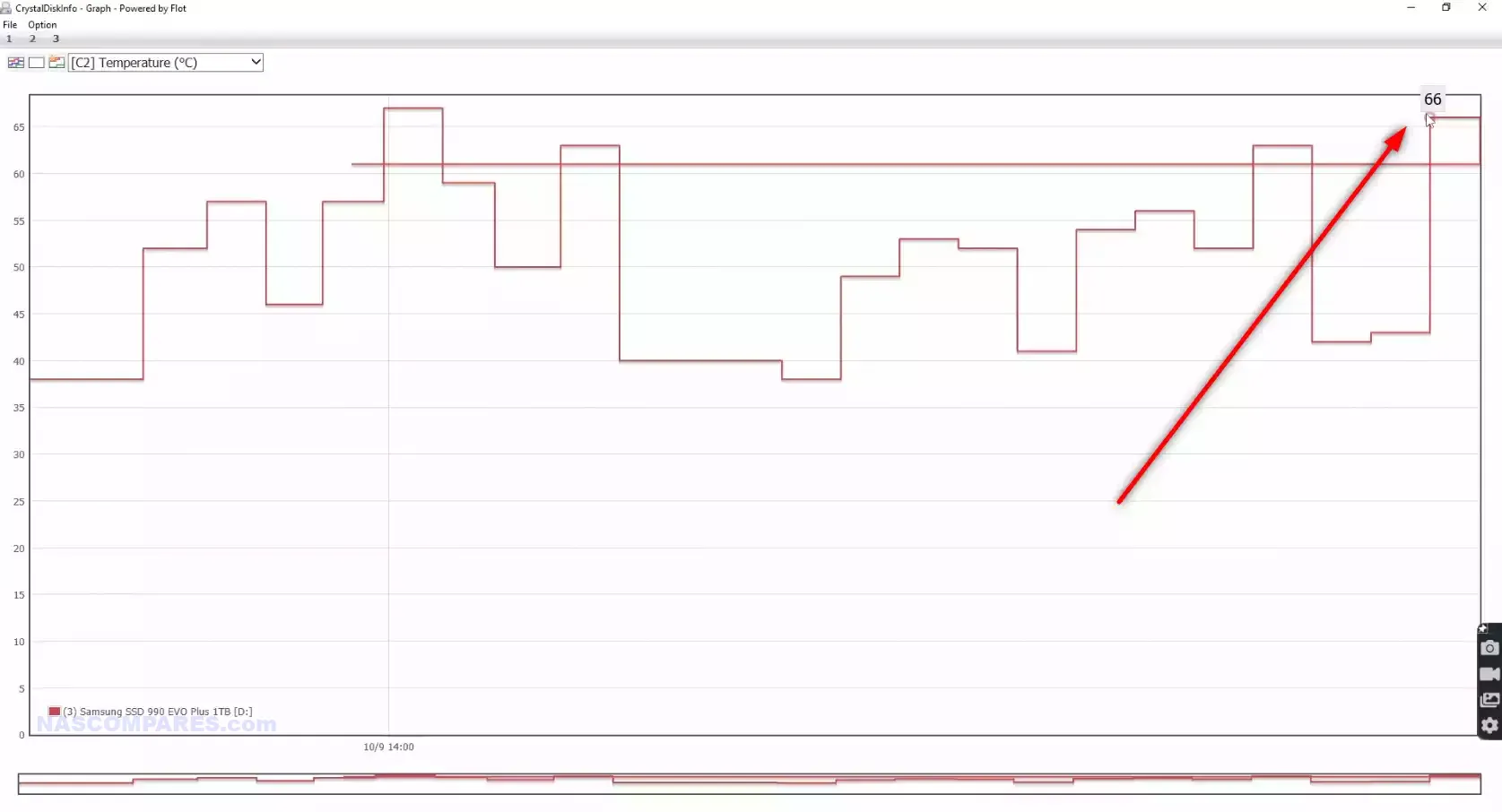
In terms of temperatures, the 990 EVO Plus fares well under load. Thanks to the nickel-coated controller and heat spreader label, the drive is able to disperse heat more effectively during sustained write operations. In testing, the drive remained below the Dynamic Thermal Guard (DTG) threshold even during prolonged workloads, meaning users won’t experience performance drops due to thermal throttling. At room temperature (25°C), the drive managed to maintain stable performance, with peak temperatures well within safe operating limits. Compared to higher-performing Gen 5 x4 SSDs, which often require larger heatsinks to prevent overheating, the Samsung 990 EVO Plus remains cool and efficient even without a dedicated heatsink. This makes it a perfect fit for users who need reliable performance without the added worry of thermal throttling, especially in small form factor PCs or other systems with limited cooling capacity.
Samsung 990 EVO Plus, Samsung 990 EVO, and Samsung 990 PRO SSD
When comparing the Samsung 990 EVO Plus, Samsung 990 EVO, and Samsung 990 PRO, each drive has been designed with distinct goals, balancing power efficiency, performance, and endurance for different user bases. The Samsung 990 EVO serves as an entry-level Gen 5 SSD, offering decent performance but focusing primarily on power efficiency and affordability. It is a great option for users who want Gen 5 speeds but are not seeking the absolute highest read and write speeds. The 990 EVO Plus takes this one step further by optimizing random IOPS performance and reducing power consumption even more compared to the 990 EVO, while maintaining low heat output and better endurance.
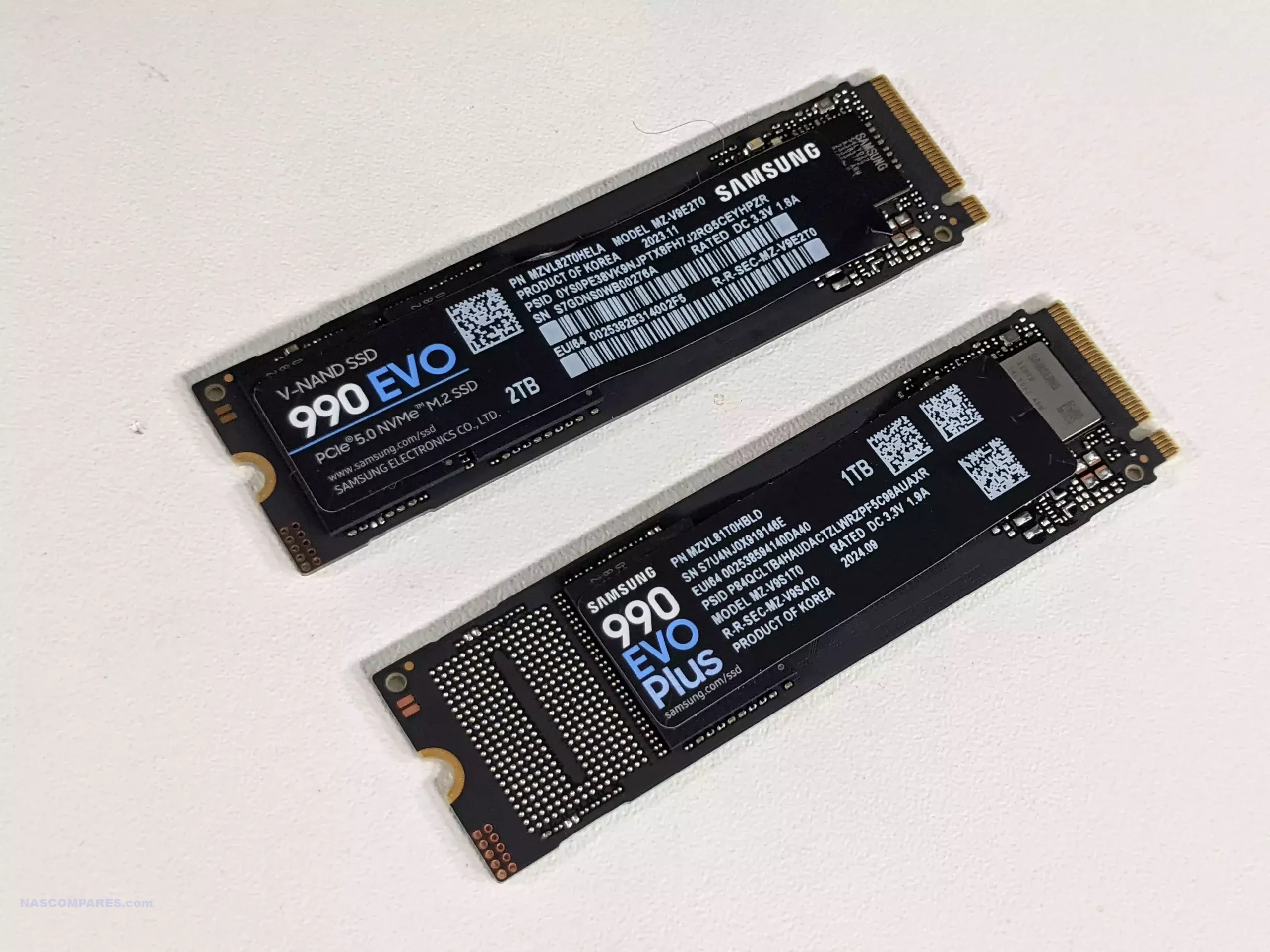
The Samsung 990 PRO, on the other hand, is Samsung’s high-end consumer SSD that prioritizes maximum performance. With a DRAM cache, high random IOPS, and faster sequential read/write speeds, the 990 PRO is designed for gamers, content creators, and professionals working with large datasets. It provides significantly higher sequential read and write speeds compared to the 990 EVO Plus, but at the cost of higher power consumption and more heat generation. The 990 PRO is also built for those seeking to use the drive in gaming consoles or high-end PCs that can handle its heat output and power requirements.
| Feature | Samsung 990 EVO | Samsung 990 EVO Plus | Samsung 990 PRO |
|---|---|---|---|
| Price | $119.99 HERE | $209.99 HERE | $369.99 HERE |
| Form Factor | M.2 2280 | M.2 2280 | M.2 2280 |
| Interface | PCIe Gen 4.0 x4 / Gen 5.0 x2 | PCIe Gen 4.0 x4 / Gen 5.0 x2 | PCIe Gen 4.0 x4, NVMe 2.0 |
| Controller | Samsung In-house | Samsung In-house | Samsung In-house |
| NAND Type | 236-layer TLC V-NAND | 236-layer TLC V-NAND | Samsung V-NAND 3-bit MLC |
| DRAM | None (HMB) | None (HMB) | 1GB-4GB LPDDR4 (Capacity Dependent) |
| Sequential Read | Up to 5,000 MB/s | Up to 7,250 MB/s | Up to 7,450 MB/s |
| Sequential Write | Up to 4,200 MB/s | Up to 6,300 MB/s | Up to 6,900 MB/s |
| Random Read IOPS (QD32) | Up to 700K IOPS | Up to 1,400K IOPS | Up to 1,600K IOPS |
| Random Write IOPS (QD32) | Up to 800K IOPS | Up to 1,350K IOPS | Up to 1,550K IOPS |
| Capacity Options | 1TB, 2TB | 1TB, 2TB, 4TB | 1TB, 2TB, 4TB |
| Power Consumption (Active) | 4.5W (Active) | 5W (Active) | Up to 8.6W (Burst Mode) |
| Endurance (TBW) | 600 TB (1TB), 1,200 TB (2TB) | 600 TB (1TB), 2,400 TB (4TB) | 600 TB (1TB), 1,600 TB (4TB) |
| Warranty | 5 years | 5 years | 5 years |
| Use Case | Entry-Level, OS Drives | Balanced Power/Performance | High-Performance, Gaming, Data-Intensive Tasks |
- Performance: The Samsung 990 PRO delivers the highest speeds, with 7,450 MB/s read and 6,900 MB/s write, outperforming the 990 EVO Plus and 990 EVO. It also offers better random IOPS, making it ideal for gaming and professional tasks.
- Power Consumption: The 990 EVO Plus and 990 EVO consume less power (up to 5W active), while the 990 PRO draws up to 8.6W in burst mode, which may not suit compact or heat-sensitive systems.
- NAND Type: The 990 PRO uses Samsung’s V-NAND 3-bit MLC, offering greater durability and performance than the 236-layer TLC NAND in the 990 EVO and 990 EVO Plus, particularly for heavy workloads.
- DRAM Cache: The 990 PRO features a DRAM cache for improved sustained performance, while the 990 EVO Plus and 990 EVO use HMB technology, which relies on system RAM, offering lower power consumption but slightly reduced performance in demanding tasks.
- Capacity Options: Both the 990 EVO Plus and 990 PRO offer up to 4TB, while the 990 EVO is limited to 2TB, making it less suitable for users needing larger storage.
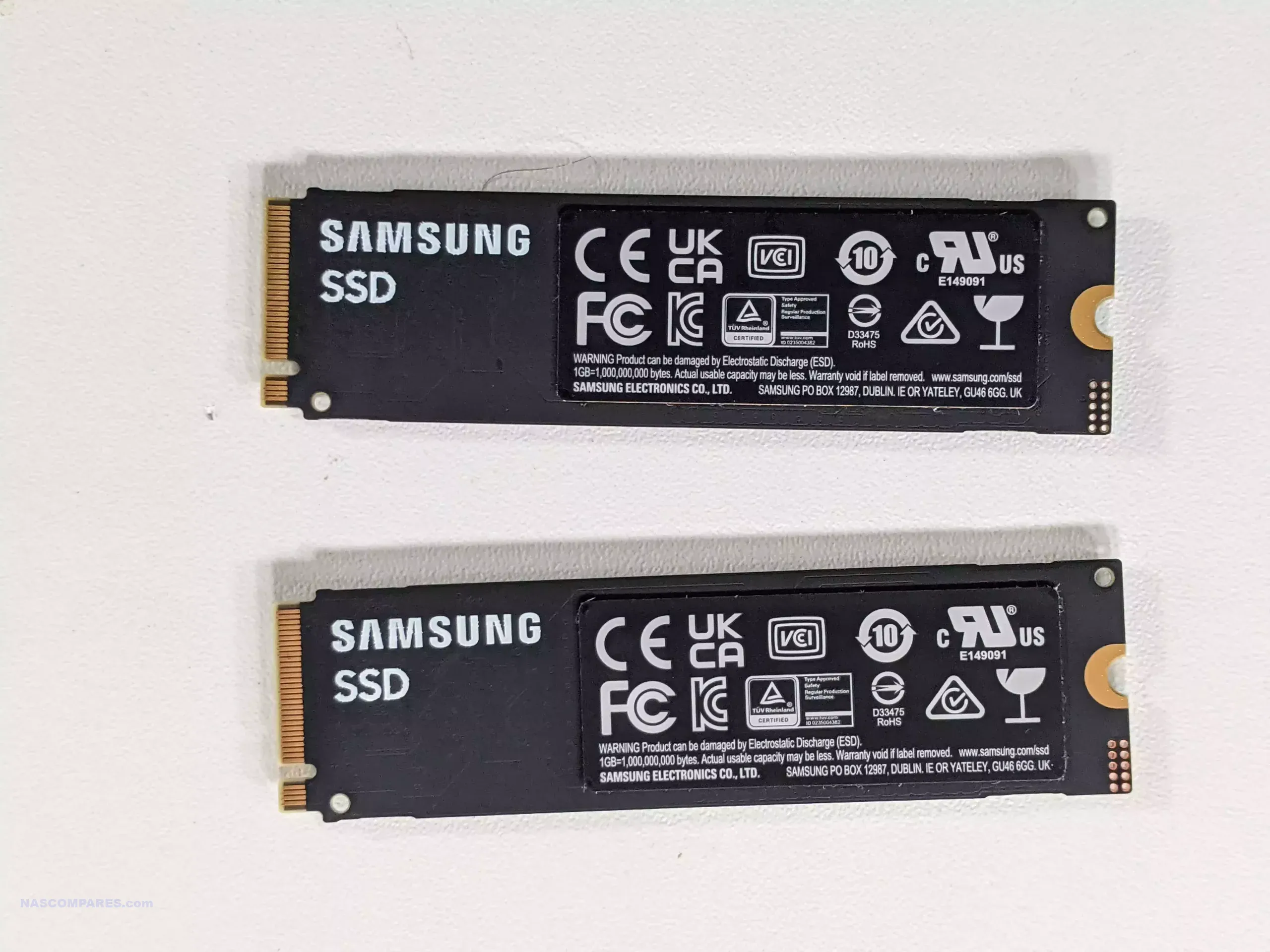
The Samsung 990 EVO Plus provides a solid middle ground between the 990 EVO and 990 PRO. It offers excellent random performance and efficiency improvements over the 990 EVO while maintaining lower power consumption than the 990 PRO. The 990 PRO, however, is the choice for those seeking top-tier performance for high-end gaming, creative tasks, and data-intensive applications, with its superior read/write speeds, DRAM cache, and higher endurance rating. The 990 EVO Plus is ideal for users who need a balance of power efficiency, performance, and thermal control, making it great for compact systems or laptops. Meanwhile, the 990 EVO serves as a more affordable option for users looking to enter the Gen 5 SSD space without needing the highest performance.
Samsung 990 EVO Plus Gen 5 SSD Review – Performance and Software
In terms of performance, the Samsung 990 EVO Plus offers a balance between speed and efficiency. Sequential read speeds are OFFICIALLY reported at peak at 7,250 MB/s, and write speeds reach 6,300 MB/s, placing it in the upper range of consumer SSDs but below some of the highest-performing Gen 5 x4 drives on the market. Where the 990 EVO Plus excels, however, is in random IOPS performance, which can reach up to 1,400K IOPS—making it a solid choice for gaming, video editing, and other random-intensive workloads.
However, despite these loft/big performance numbers, it is worth noting that these were achieved with a hefty AMD Ryzen9 7950x 16-Core Processor CPU@4.5GHz by Samsung – A system that I think would not typically be used with a DRAMless SSD (as that is a power user rig). So, I decided to run tests on my much more domestic OS class 12th Gen Intel i5 system, wit h1GB DDR5 Memory, in a Windows 10 environment and with the OS running from an Gen4 SSD. Here were my results:
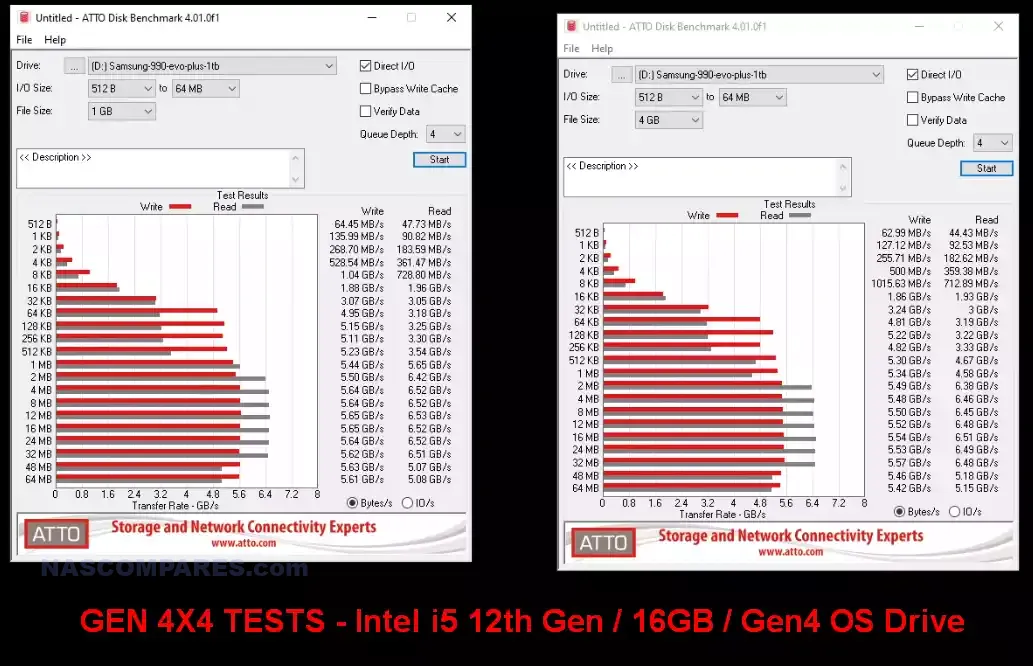
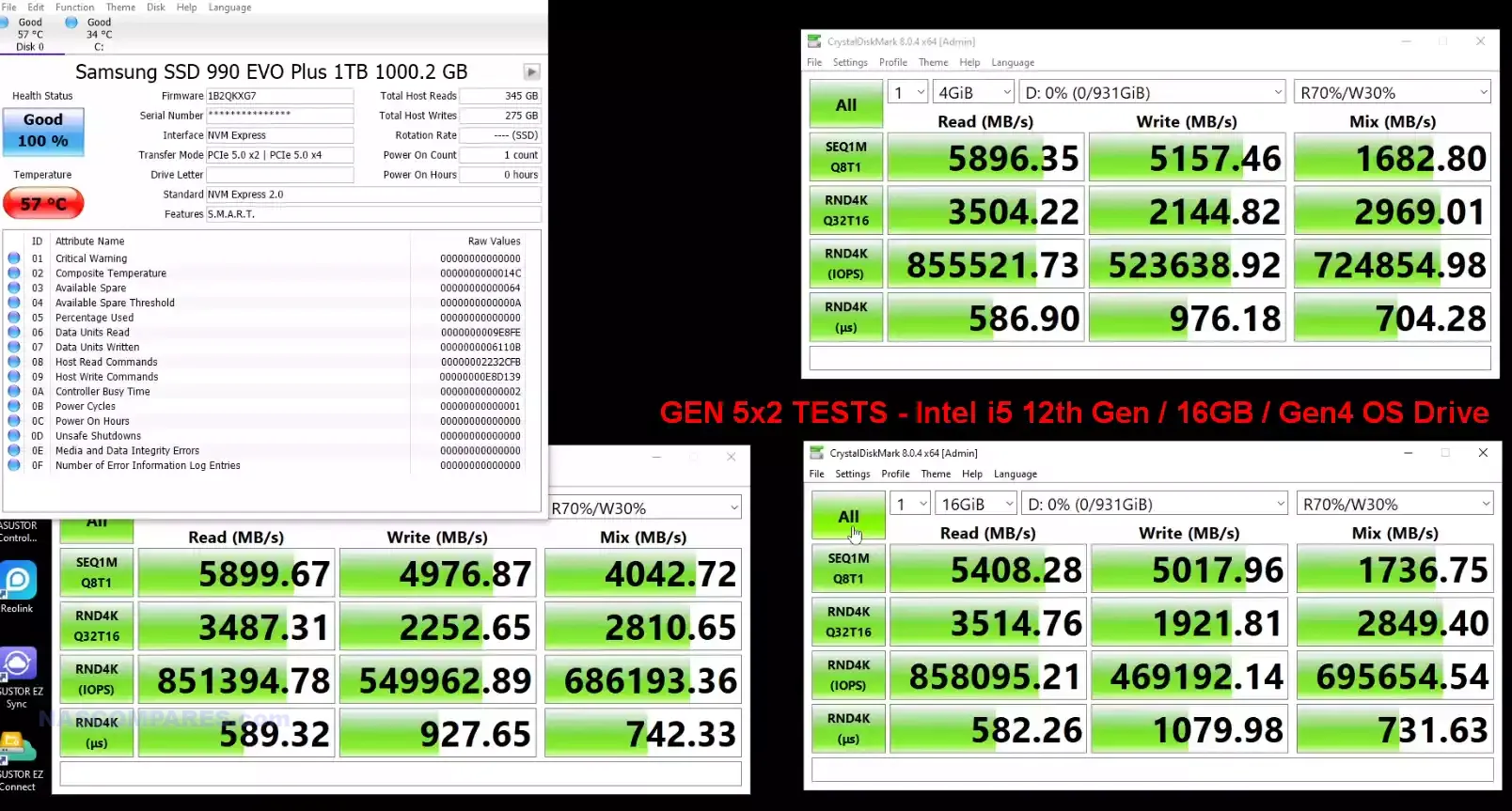
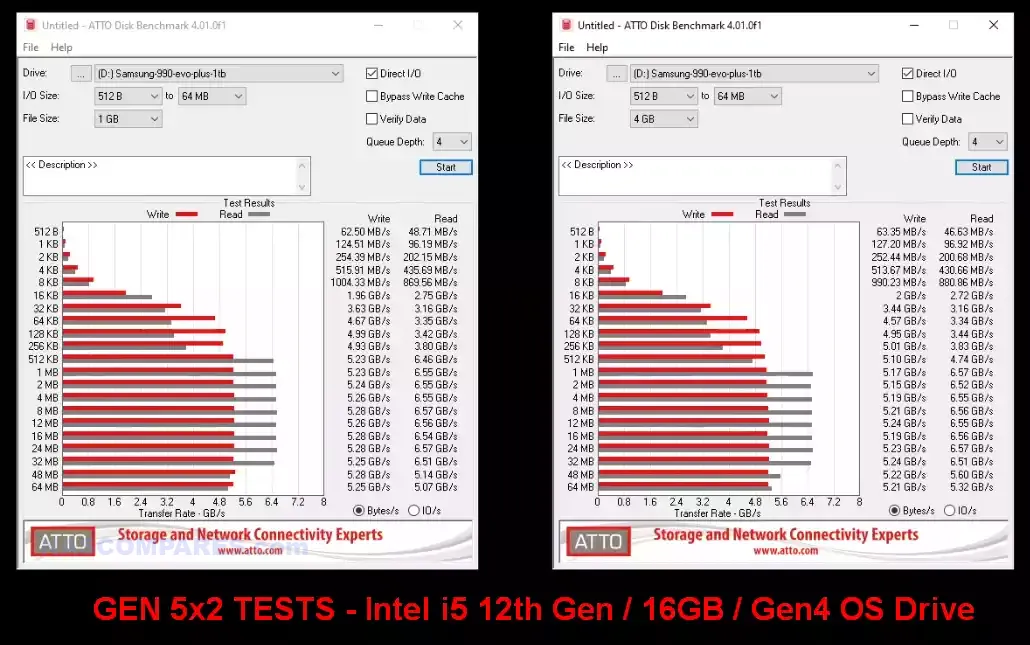
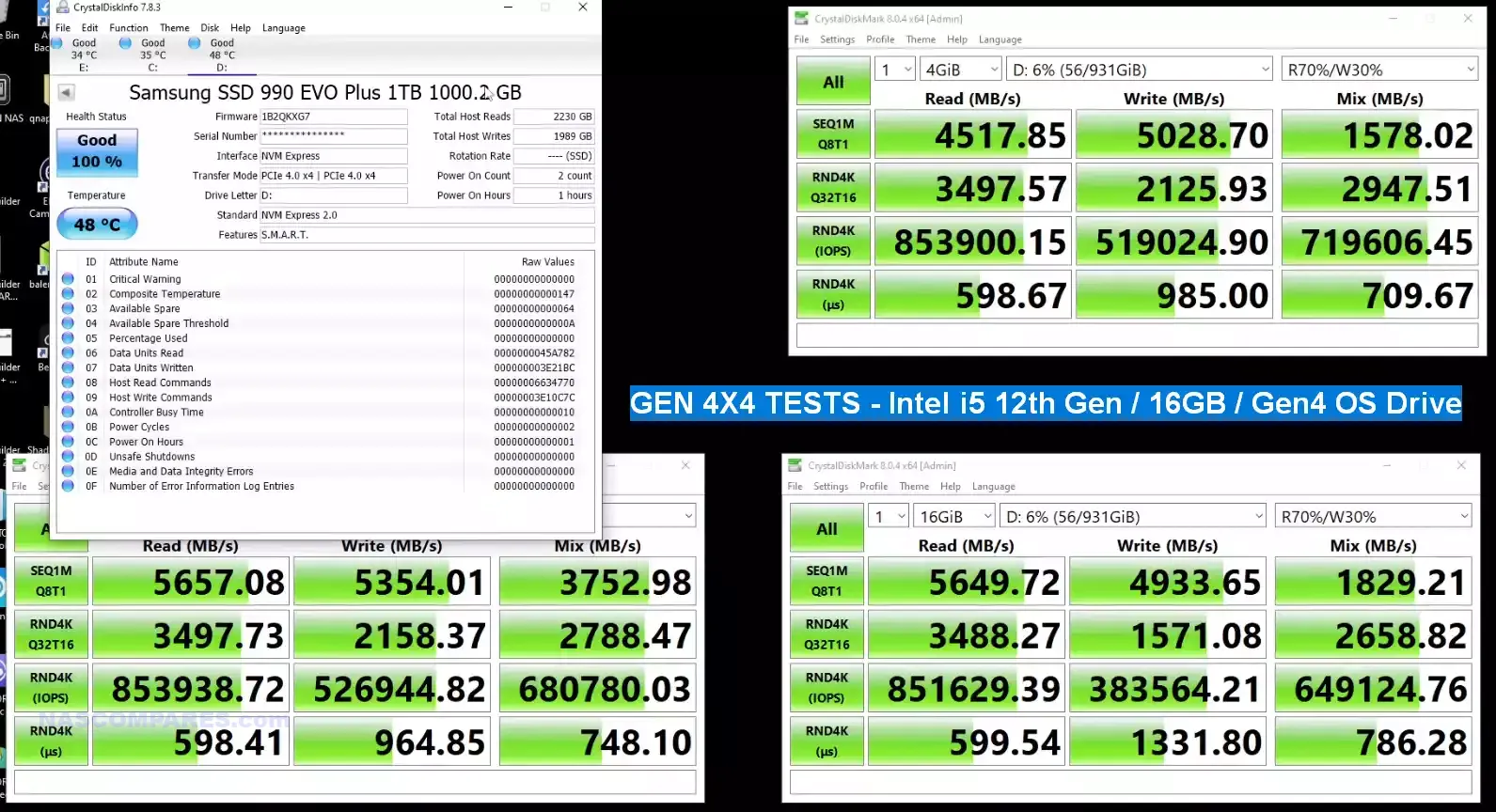
I appreciate that these are much lower AND are using synthetic tests, but even in a Windows 55GB transfer, I never saw higher than 6.5GB/s. This same system has regularly achieved 10GB/s on Gen 5×4 SSDs and 7GB on Gen4 SSDs – but THOSE SSDs were using DRAM. Using this DRAMless SSD in that system was around 1-1.5GB/s less than the system that Samsung used, but despite both system relying heavily on HMB – the much more powerful rig was clearly able to allow higher speeds to be possible:
(The Official Testing by Samsung)
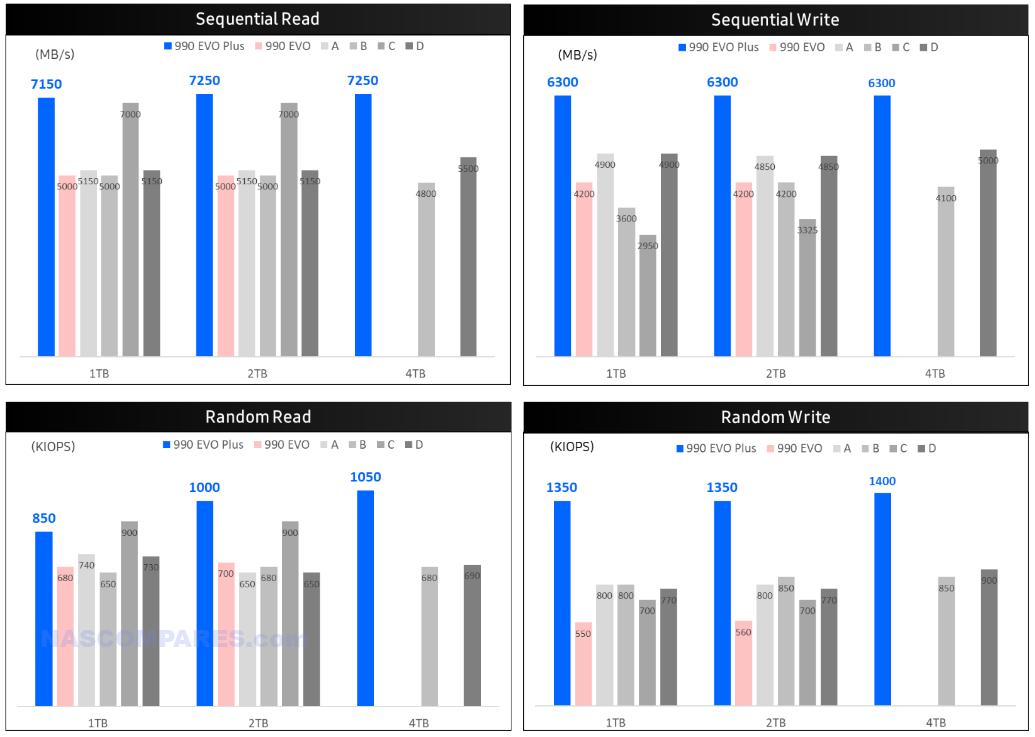
FULL performance testing can be found in the review video HERE:
Benchmarks like PCMark10 and 3DMark show that the 990 EVO Plus performs well in real-world scenarios, particularly in applications where random performance is crucial. In gaming benchmarks, the 990 EVO Plus performed comparably to some of the best Gen 5 SSDs, particularly in load times and 3D rendering tasks. For content creators, the drive’s ability to handle 8K video editing and high-resolution graphics workloads is a testament to its strong random performance. Samsung Magician, which has long been one of the best SSD management tools on the market, continues to be a highlight with the 990 EVO Plus. The latest version, Magician 8.2, offers even more advanced features, including real-time drive health monitoring, firmware updates, and performance optimization tools. It also supports partition management and RAID configurations, making it a versatile tool for professionals and casual users alike. Just keep in mind that you are definitely going to need a powerful, POWERFUL rig if you hope to hit the reported 7GB/s+ performance that Smasung maintain this 4×4/5×2 DRAMLESS SSD can hit.
Samsung 990 EVO Plus Gen 5 SSD Review – Verdict
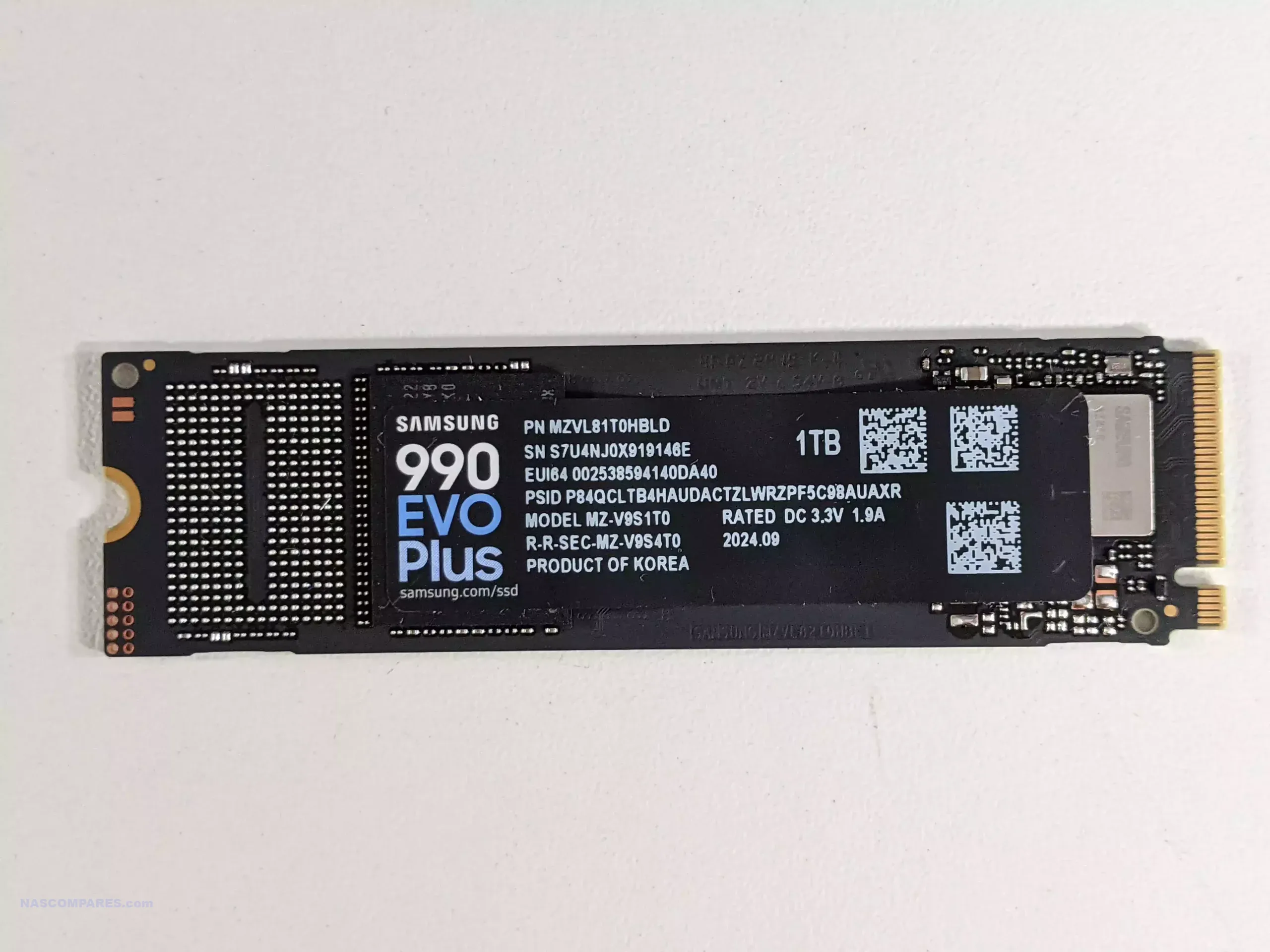
The Samsung 990 EVO Plus is a well-rounded SSD that balances power efficiency, random performance, and thermal management—making it an excellent choice for users who prioritize reliability and efficiency over raw speed. Compared to the 990 EVO, it offers significant improvements in power consumption and random performance, while still maintaining the same level of durability and endurance that Samsung is known for. However, for users who demand the absolute best in terms of sequential speeds or IOPS for gaming and data-heavy workloads, the 990 EVO Plus may not be the fastest option available. The lack of DRAM and the reliance on HMB technology might not appeal to those looking for top-tier performance, but for everyday users and professionals working with large files, this drive provides a reliable, long-lasting solution. The Samsung 990 EVO Plus shines as an efficient, reliable SSD for users who need dependable storage without the high power draw or heat output of some other Gen 5 SSDs. It may not be the fastest drive on the market, but its balance of power efficiency, random performance, and thermal management makes it a compelling option for a wide range of users. HOWEVER, be aware that this is a drive that is built for efficiency and if used in a mid-range system, will not hit the same performance numbers that a DRAM equipped SSD would be able to achieve. It’s another example of Samsung pursuing a different SSD marketing and production strategy than Seagate and WD, but it’s still too early to see if this will be ultimately successful in the battle of Speed vs Efficiency vs Price in 2024/2025!
| PROs of the Samsung 990 EVO PLUS SSD | CONs of the Samsung 990 EVO PLUS SSD |
|
|
Need More Help Choosing the Right Storage Solution?
Choosing the right data storage solution for your needs can be very intimidating and it’s never too late to ask for help. With options ranging from NAS to DAS, Thunderbolt to SAS and connecting everything up so you can access all your lovely data at the touch of a button can be a lot simpler than you think. If you want some tips, guidance or help with everything from compatibility to suitability of a solution for you, why not drop me a message below and I will get back to you as soon as possible with what you should go for, its suitability and the best place to get it. This service is designed without profit in mind and in order to help you with your data storage needs, so I will try to answer your questions as soon as possible.
📧 SUBSCRIBE TO OUR NEWSLETTER 🔔 This description contains links to Amazon. These links will take you to some of the products mentioned in today's content. As an Amazon Associate, I earn from qualifying purchases. Visit the NASCompares Deal Finder to find the best place to buy this device in your region, based on Service, Support and Reputation - Just Search for your NAS Drive in the Box Below
🔒 Join Inner Circle
Get an alert every time something gets added to this specific article!
Need Advice on Data Storage from an Expert?
Finally, for free advice about your setup, just leave a message in the comments below here at NASCompares.com and we will get back to you.
 Need Help?
Where possible (and where appropriate) please provide as much information about your requirements, as then I can arrange the best answer and solution to your needs. Do not worry about your e-mail address being required, it will NOT be used in a mailing list and will NOT be used in any way other than to respond to your enquiry.
Need Help?
Where possible (and where appropriate) please provide as much information about your requirements, as then I can arrange the best answer and solution to your needs. Do not worry about your e-mail address being required, it will NOT be used in a mailing list and will NOT be used in any way other than to respond to your enquiry.
TRY CHAT
Terms and Conditions


UGREEN iDX6011 Pro NAS Review
Beelink ME PRO NAS Review
UGREEN iDX6011 Pro - TESTING THE AI (What Can it ACTUALLY Do?)
OWC TB5 2x 10GbE Dock, UGREEN NAS Surveillance Software, AceMagic Retro PCs, Gl.iNet Comet 5G @CES
What IS the Digiera OmniCore NAS? Is it Worth $599?
New UGREEN NAS Expansion, DXP4800 PRO NAS and eGPU Revealed
Access content via Patreon or KO-FI
Discover more from NAS Compares
Subscribe to get the latest posts sent to your email.


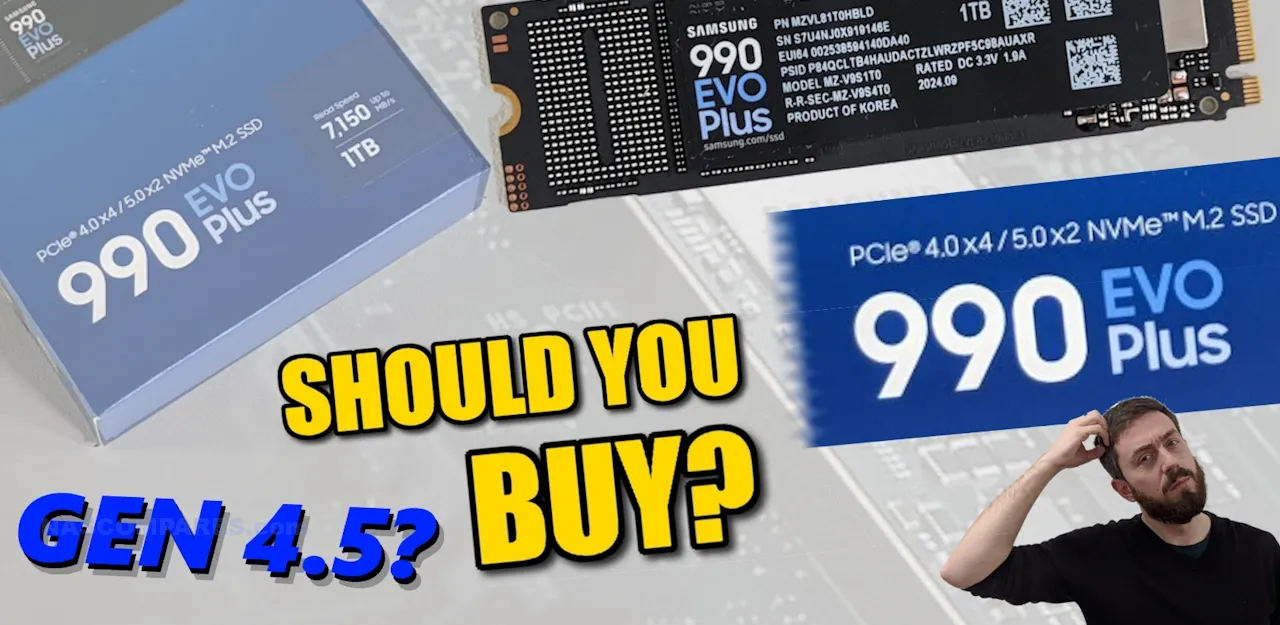




Man the YouTube algorithm has some DEMONIC timing with this one as it pushed this video during RAMmageddon
REPLY ON YOUTUBE
Just got 1 for $79 US
REPLY ON YOUTUBE
i have the same 1tb, on a ryzen 7 8745hs mini PC. Tested on crystal disk i got 6900 read and 5800 speeds… Not too far off from the advertised speeds. im happy with my purchase ,.. it only cost me about 70 dollars.
REPLY ON YOUTUBE
Is this compatible with the ps5? Does anyone know?
REPLY ON YOUTUBE
I don’t think some of your comparisons are entirely fair in being attributed entirely to lack of DRAM.
Difference in performance may be down to the tier of the product, not just because of a lack of DRAM.
Plus the choice of NAND matters, as more smaller modules vs fewer larger ones means potentially more channels to operate in parallel.
Think of it like RAID, 4x1TB disks have twice the bandwidth over 2x2TB.
REPLY ON YOUTUBE
I got a 4TB for 200$ on eBay brand new!!
REPLY ON YOUTUBE
Since Gaming is more read than write for the SSD, this should be a good for gaming, right?
REPLY ON YOUTUBE
I built a computer few years ago ASUS Tuff motherboard with AMD Ryzen 7, 32 GB Ram and bought the Samsung 980 Pro 1 TB. Samsung app benchmarks show it over 6,000 mbps. I bought a second 2tb drive for other slot to use to backup data. Both seem to work flawless. Upgraded to Windows 11 Home. I just bought one of the Samsung EVO Plus 1 tb drives for spare drive when needed or to build another computer later. Just bought it from Amazon 1TB $59.99. Not a huge discount but good.
REPLY ON YOUTUBE
I’m not getting those numbers.
I get 4065 Read
6584 Write
259 random read on the 4TB plugged into the M.2 4.0 slot
REPLY ON YOUTUBE
I had an Acer Fa100 (hbm) that had stutters in Forza Horizon and didn’t load the grass in Skyrim. My Kingston sata ran those games fine. Since then I prefer XPG budget Dram TLC ssd’s.
REPLY ON YOUTUBE
These drives are really meant for desktop users that may need to bifurcate lanes such as AMD x870 chipsets that output USB4 that may share lanes with the 2nd nvme slot. In these cases, the lanes are split into x2 and kept at gen 5. Otherwise, the gen 4×4 nvme ssd winds up disabling USB4. Ultimately resulting in the drive, when paired with a higher-end CPU, that can leisurely handle up to 7250MB/s while keeping USB4.
REPLY ON YOUTUBE
6:32 ddr5 3200mhz????
REPLY ON YOUTUBE
The difference in 4.0 is no different but slight write by 5%
REPLY ON YOUTUBE
excellent d-mystifying 🙂
REPLY ON YOUTUBE
Great video
REPLY ON YOUTUBE
Beautifully explained, clean and crisp. Thanks my man!
REPLY ON YOUTUBE
I dont want to be THAT guy, but bro, you repeat yourself so much in this video, as well as stating so much “Duuuaahh” stuff. 15 minutes could’ve been compressed into a 3 minute video.
REPLY ON YOUTUBE
Doesn’t M2 queries CPU every time it needs HMB? Is done trough the CPU as long as I know.
How many times CPU will be queried because HMB by the M2 as OS drive for windows with several writes and reads done by OS?
Is even worth considering 2 watt less in power efficiency when CPU is queried by M2 and CPU can consume way more watts that the actual savings of DRAM less M2?
REPLY ON YOUTUBE
The local Walmart has 2TB version of this SSD reduced to $72.50 and I’m wondering for using it as a Steam game backup drive if that’s a decent deal…. ?
REPLY ON YOUTUBE
I will never buy this crappy SSD. I won’t be fooled. I’ve always used Samsung and am very disappointed. These new SSDs have become more fragile and not so efficient. Why so many MB per second if the rest is bad? Small files still transfer extremely slowly. If a file transfers at over 7000 MB per second for a short time and then gets extremely hot, then the transfer is not good at all. I’d rather have 3500 MB per second, and my SSD stays cooler.
REPLY ON YOUTUBE
I have 2 of the 2tb ones on an i9, and I have around 7gb read and 6gb write. Brand new ????
REPLY ON YOUTUBE
Great video my man I was curious about this SSD considering it’s only like $120 right now for 2tb
REPLY ON YOUTUBE
10:17 HMB isn’t support on in MacOS.
REPLY ON YOUTUBE
Saved me a purchase. Forgot how complex drives are these days.
REPLY ON YOUTUBE
Bra yo PC sucks I get 7.3k download with this just like the box said your pc sucks!
REPLY ON YOUTUBE
No SN5000 review?
REPLY ON YOUTUBE
600 TBW means : 600/5 years=120TBW/year /365 days = 0.329TBW/day. That means that you can use only 32.9% of disk capacity per day . SEAGATE fireguda 500R has 1200TBW wich means 65.8% usable capacity per day and CARDEA offer 98% usable capacity per day KINGSTONE FURY has 1100TBW which means 60% usable capacity per day and all these NVMes have above 7000MB/sec reads and writes.
So pay attention where You spend your money….
REPLY ON YOUTUBE
A lot of things to think about here. I do use virtual machines on one of my desktops and it would probably benefit from a DRAM SSD. I do sustained writes though I don’t know if that’s a performance factor yet.
REPLY ON YOUTUBE
You talk a lot!
Fast and unpleasant
And a lot of nonsense
Shorten your videos and be businesslike!
REPLY ON YOUTUBE
You talk a lot!
Fast and unpleasant
And a lot of nonsense
Shorten your videos and be businesslike!
REPLY ON YOUTUBE
I bought the 2TB 990 EVO for $119 from Amozon on sale to use in a $60 40GB/s Enclosure with my new M4 Mac Mini Base model. It runs in the BMD Speed test faster than the actual 256GB/s internal.
REPLY ON YOUTUBE
DRAM-less SSD may be cheap, but it will be a terrible idea if these DRAM-less SSD installed onto vintage PC/laptops especially Macbook 2009 models and even older videogame consoles.
REPLY ON YOUTUBE
Great video on DRAM vs DRAM Less SSD.
REPLY ON YOUTUBE
Would using these 990 evo solve problem with GPU getting only 8 lanes when 2 nvme are used in the first two slots of x870e motherboards?
REPLY ON YOUTUBE
For os installation for a old 6-7 year old laptop which one should i get plz help
REPLY ON YOUTUBE
does it work with ps5
REPLY ON YOUTUBE
All these tests are of no use to me if at sustained speed it does not maintain a transfer of at least 50% of its maximum transfer speed at his complete capacity.
REPLY ON YOUTUBE
I was looking forward to this ssd but the lack of dram ruined it for me
REPLY ON YOUTUBE
Problem when ppl say lower write speed, “lower” is relative, it wont drop to like HDD 5400RPM levels 🙂 In the end it feels like if you have to ask the question what drive to buy you most likely wont notice the difference 🙂 Dont forget that not too long ago SSDs were still pretty rare, HDDs did not had RAM in them and somehow all worked. Im using WD RED HDDs in my NAS and sure, its not fun when I need to transfer say 40-50Gb from it to my SSD for whatever reason, but its not like Im doing it every day.
REPLY ON YOUTUBE
when it comes to gaming using it for a AM4 motherboard. Is it worth getting the 2TB Samsung EVO Plus????
REPLY ON YOUTUBE
No need to get this; I looked up the GM7000, and the specs are almost the exact same, no big difference, and that cost $50.
REPLY ON YOUTUBE
Have T500 for my PC and T500 for PS5.
REPLY ON YOUTUBE
Essentially when fabricating the chips there are failures. They dont want to throw away potential $$
REPLY ON YOUTUBE
This was an excellent explanation on the pros n cons of dramless.and dram ssd.
REPLY ON YOUTUBE
If they could release an 8 TB (and possibly even a 16 TB) model then these would make sense.
REPLY ON YOUTUBE
The Crucial T500 is a better buy than any of the 990 EVO, Plus or pro version of NVMEs. It only costs 7 bucks more than the 990 EVO Plus has DRAM and runs cooler. It was tested without a heatsink and no air and it only hit 65*C; with a heatsink the T500 only hit 52*C (tech testers YT channel). It runs much faster than the 990 EVO plus (even beats the 990 Pro). Sammy needs to step up their SSD game.
REPLY ON YOUTUBE
Does it not benefit the Lane restricted NAS devices, like QNAP and their expansion cards? assuming of course the bottleneck isn’t your network speed.
REPLY ON YOUTUBE
I have the UGreen DXP2800. If you had to choose a specific SSD 1 for read and 1 for write as cache, what would it be?
REPLY ON YOUTUBE
How would you rate the evo plus in comparsion to a 990 pro, thanks
REPLY ON YOUTUBE
I pre ordered 4 of these, but then the 2TB type. They will be installed in an Asus Hyper m.2 Gen 5 card.
Ryzen 9000 series cpu’s have 28 pci-lanes. So in total 8 pci-lanes for my Hyper card, 16 lanes for my graphics card and 4 pci lanes for the chipset 🙂
REPLY ON YOUTUBE
Great video. Would you consider reviewing the new rtx 2000 ada 16gb gpu? No one has made a meaningful video on it, and I have to use commercial-grade gpus since they support 64x msaa for 3d modeling. Consumer grades only go up to 16x ????♂️
REPLY ON YOUTUBE
we just need more pci lanes on consumer cpu’s !
REPLY ON YOUTUBE
Please compare that to evo and 990 pro with graphs if its possible!
REPLY ON YOUTUBE
does it work with DS920+?
REPLY ON YOUTUBE
5:53 Having just one NAND chip will reduce performance with “defrags” (sic)
REPLY ON YOUTUBE
Excellent presentation. Thank you. I have always been fan of Samsung NVMe drives and have a bunch of PCIe 3 and 4 Pro drives. That said, I am not impressed with this drive and would not buy one. Frankly it shouldn’t be considered an “EVO” in my opinion. It seems like they are leveraging that moniker and hoping folks wont do their homework.
REPLY ON YOUTUBE
No DRAM no buy
REPLY ON YOUTUBE
Fair warning: such M.2 SSD’s are *not* always usable in NAS systems. As this SSD-types expects the HBM, which not all NAS operating system might support. I do hope that Sams0ng does not go down the same road as USB3 scheme’s, obfuscating that is merely a cheaper/affordable version (IMHO) and making it harder for us all to identify.
I myself will wait at least a year to allow for the dust to settle-down for Gen 5 ssd’s.
Starts to smell like SMR to me! (joke)
REPLY ON YOUTUBE
It’s really a jungle for Samsung SSD… As you already review SSD for the console PS5,
can the Samsung 990 EVO PLUS be a good option for gaming or do we need to keep searching for a Samsung 990 PRO ??
I’m confused now….????
Oh .. I wrote my message before the end of the video… it’s NOT good for gaming.. OK ….
REPLY ON YOUTUBE
4×4/5×2 maybe they know the computer future will have some issue for provide enough pcie lanes
High speed signaling is complex and expensive , less lanes overall platform makes sense (keep cost and price reasonable)
REPLY ON YOUTUBE
Not very impressive and suspect the price won’t reflect that. Why bother…
REPLY ON YOUTUBE
I have been asking for higher gen and less lanes for the longest time. Imagine getting to have full bandwidth of your gpu with half the lanes allocated.
REPLY ON YOUTUBE
When a semiconductor device like this has million versions of the same thing. I assume that there is a problem with yields. As there are few reasons to have such variations in a single device. It has to be that the binning process is creating a wide range of dies that do not hit the expected spec.
REPLY ON YOUTUBE
3:04 You blew it even with the correction.
REPLY ON YOUTUBE
Lol I bet the guy who named Samsung drives is also the same guy who named USB
REPLY ON YOUTUBE
When Samsung 9100 pro gen 5 ssd released date please
REPLY ON YOUTUBE
I”m happy to finally see x2 NVMe drives comming to the mass-market, but as long as you won’t be able to allocate how much lanes your slot use, it’s uselfullness will be moot. For now, no matter what you plug on any M.2 (storage) slot, in 99% of the case, 4 lanes will be reserved for it.
REPLY ON YOUTUBE
Ps5 test ?
REPLY ON YOUTUBE
Great info, so much to consider when buying an SSD.
REPLY ON YOUTUBE
its not about the speed , its about durability
REPLY ON YOUTUBE
Excellent video
How about video editing?
Is dram necessary?
REPLY ON YOUTUBE
How about external SSD‘s for Time Machine backups. Is there a advantage with DRAM?
REPLY ON YOUTUBE
Dram-less SSD – the official SSD for all pedophiles
REPLY ON YOUTUBE
I don’t think it’s possible to make more entertaining videos about the world of NAS. You do a great job and I have surprised myself by watching videos that transcended my personal usefulness. Not to mention how well structured and dense the website is…
Just one thing, I miss some seagulls in the recordings ????
REPLY ON YOUTUBE
Dramless are usually slower. And cheaper. Safe choice use dram
REPLY ON YOUTUBE
sorry but that is complete nonsense! DRAM on SSDs is only used for the lookup buffer. So where data is on the SSD, not to buffer data. It’s definitely faster with DRAM. But if you have no idea about the technology you shouldn’t make YT videos!
REPLY ON YOUTUBE
Hi, great video, when will you be testing the lexar in a ps5, waiting on your test before I buy.
Thanks for making these videos, really helpful. Cheers.
REPLY ON YOUTUBE
Not great once turfed out to an usb enclosure.
REPLY ON YOUTUBE
Great primer, I can see this getting a lot of views and being informative to those viewers.
REPLY ON YOUTUBE
I noticed a bottleneck with my old dramless nvme 3.0 drive when downloading games from steam as the drive would hit 100% usage and the speeds would slow to a crawl. After upgrading to a 990 pro, I can now download steadily above 2 gbps. My old 3.0 drive on paper had great performance specs in terms of sequential and even random speeds but I had no idea back then about dram and how it affects sustained performance and multitasking.
REPLY ON YOUTUBE
useful info there!
as I see it, the only advantage is power efficiency for laptops and other portable devices,
but for any decent desktop PC, server or NAS, dedicated DRAM is a no brainer….
maybe, just maybe, if the prices of DRAM-less SSDs dropped on par with HDDs, then as a replacement for HDDs it could become viable alternative…
REPLY ON YOUTUBE
Let’s be honest, flash-memory is still not really fast memory and that durable. (compared to other storage solutions)
The RAM helped the algorithms to reduce the wear-and-tear. (and indeed, at times, the performance as noted in this video)
Dropping the on-board RAM is next to a cost-saving move also because of chip-shortages, which is still a thing.
I do agree omitting RAM may not impact that much in several applications but for modern-day NAS, in my opinion, you will need it.
And FYI dramless is something that has been ongoing since (about) 2017.
Back then it was really, really bad on almost every level. Nowadays it has improved substantially. (controller & algorithms)
It is the same as with the number of flash-chips (as you mentioned), the amount of layered flash-cells per chip, it is about costs and not always to the benefit of the users/application.
When you want to obtain SSD’s, it is nowadays really an intens study, figuring out the various caveats.
REPLY ON YOUTUBE
As always an excellent video.
Really hones on the importance of DRAM
REPLY ON YOUTUBE
At Gen 4/5 speeds, DRAMless is plenty fine for situations mostly dependent on reads that rarely experience intensive writes.
I use two DRAMless drives in my DIY NAS — one for boot drive, one for app drive — because DRAM would give no performance benefit and not be worth the extra money.
REPLY ON YOUTUBE
Loves these videos on all the different m.2 drives. Question, is the temperature testing video of HK Hynix m.2 heatsink in the PS5 still coming? Interested to see how it compares to the other ps5 heatsinks.
REPLY ON YOUTUBE
6:59 – “One Small Security Blip:” Are you sure data can be retrieved from powered down DRAM? It’s volatile memory isn’t it? How can data be pulled off this if it’s been powered off / pulled out of the host system? Cheers.
REPLY ON YOUTUBE
Have you seen this case @NASCompares? It’s called the “Space Auriga” amongst other things. Found on AliExpress here:
https://www.aliexpress.com/i/1005004999784255.html
The big selling point for me is it takes mATX motherboards and ATX power supplies.
REPLY ON YOUTUBE
Good one mate – Thanx????????????
REPLY ON YOUTUBE
Your most recent set of videos with text chapter separators and the silly little sounds are very annoying. Those of us who listen as opposed to watch have no idea what the following discussion is in relation to. Your older videos were great learning tools because so little of it was “see this part here” content requiring I be right in front of the TV. Perfect to listen to while doing dishes, putting away items, etc. Even if it’s one of those stupid automated readers, please add audio to your topic changes so I can follow the remaining discussion.
REPLY ON YOUTUBE
Had a question!!! Does dram or not affect even for using as an external ssd ( as used as an external storage device ) ! And how do I upgrade the firmware in an enclosed ssd ? Thank you ???? Your videos are so informative ????
REPLY ON YOUTUBE